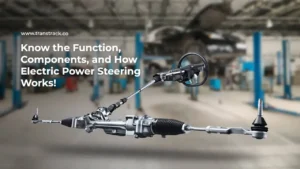Signs and Expiration Time of Car Tire and Maintenance
Posted on July 24, 2024 by Nur Wachda Mihmidati

Car tires are one of the most important components of a vehicle that often receives less attention in maintenance. However, did you know that tires also have an expiration date? While they may look fine visually, expired tires can pose a major risk to driving safety. Overly old or damaged tires not only reduce vehicle performance but can also increase the risk of accidents. In this TransTRACK article, we will discuss the signs of expiration car tire and the important steps to maintain them to keep them safe and efficient.
How do I know if my car tires are expired?
To know if your car tires have expired, you can check the following points:
Check Production Date
Check the DOT code on the side of the tire wall. This code usually consists of four digits, with the first two digits indicating the week and the last two digits indicating the year of production. For example, the code “2319” means that the tire was produced in the 23rd week of 2019.
Check the Expiration Date
Tires are generally recommended to be replaced after 6 to 10 years, although they may require replacement sooner if they show signs of damage or wear.
Check for Wear and Damage
Check for signs such as cracks, bumps, or groove depths that are already less than 1.6mm. Uneven wear can also indicate problems with the tires or suspension.
Ask a Professional
When in doubt, you can request an inspection from a professional tire shop or technician. They can provide a more in-depth assessment of the condition of your tires.
Keeping tires in good condition is essential for safe driving.
What are the effects of using expired tires?
Using expired car tires can have several negative impacts, including:
Decreased Driving Performance
Expired tires tend to lose rubber and elasticity, resulting in decreased grip and traction. This can affect driving ability, especially in bad weather conditions.
Risk of Tire Rupture
Older tires may have cracks or structural damage. This increases the risk of a sudden tire blowout while driving.
Balance and Control
Wear or deformation on expired tires can impair vehicle balance and control, making it difficult to drive safely.
Decreased Fuel Efficiency
De-optimal tires can increase frictional resistance, which impacts the fuel efficiency of the vehicle.
Potential Safety Hazard
Damaged or substandard tires can increase the risk of accidents due to failure in emergency situations.
Overall, it is important to replace tire that have expiration or show signs of damage to maintain the safety and performance of your vehicle.
What are the signs of expired tires?
Signs of expiration tire include:
Cracks on the Tire Surface
Cracks on the sidewall or tire surface indicate that the rubber has hardened and lost its elasticity.
Worn and Thinning Tire Surfaces
Thinning tread grooves or tire surfaces that no longer have sufficient depth can reduce grip and traction.
Decreased Tire Performance During Use
If you notice performance degradation such as shaking, noise, or unstable handling, it could be that the tires have deteriorated.
General Tire Condition
Check for bumps, swelling, or other physical damage. This could indicate internal damage to the tire.
Tire Age
Check the production date on the DOT code. Tires are generally recommended to be replaced after 6 to 10 years, although their physical condition may require replacement sooner.
If you notice any of these signs, you should replace your tires immediately to maintain safe driving.
How to maintain tire so that they do not having expiration quickly?
To take care of tires so that they don’t expire quickly, you can take the following steps:
Maintain Appropriate Tire Pressure
Check the tire pressure regularly and make sure it is in accordance with the manufacturer’s recommendations. Too low or too high pressure can cause uneven wear and shorten tire life.
Avoid prolonged exposure to direct sunlight
Park your vehicle in a shaded area or use tire protectors if you park outdoors for a long time. Direct sunlight can accelerate the drying process and damage tire rubber.
Perform Regular Tire Rotation
Perform regular tire rotations (about every 5,000 to 8,000 kilometers) to ensure even wear and extend tire life.
Checking and Adjusting Tire Balance
Make sure the tires are balanced. Unbalanced tires can cause uneven wear and problems with the suspension system.
Avoiding Overloading
Do not carry loads beyond the capacity recommended by the manufacturer. Overloading may increase tire pressure and accelerate wear.
Check Suspension and Wheel Condition
Make sure the suspension system and wheels are in good condition. Damage to the suspension or wheels can affect tire performance and accelerate wear.
Avoid Potholes and Rough Surfaces
Avoid driving on potholes or rough surfaces that can damage your tires and shorten their life.
By taking good care of your tires, you can extend their life and maintain safe driving.
Expired car tires can pose a serious risk to your driving safety and vehicle performance. To keep your tires in optimal condition and avoid potential problems, perform regular inspections, maintain tire pressure, and make sure your tires are not exposed to direct sunlight for long periods of time.
To make your vehicle maintenance more manageable, consider using TransTRACK’s Vehicle Maintenance System. Our system makes it easy to monitor and manage the condition of tires and other vehicle components in real-time, so you can more quickly detect and address problems before they become risks.
Contact us today for more information and improve the safety and efficiency of your vehicle with the latest technology from TransTRACK!
Recent Post
Know the Function, Components, and How Electric Power Steering Works!
December 24, 2025Know the Types of Buses Based on Their Model, Size, and Capacity!
December 22, 2025Topic :
Recommended Articles

 Bahasa Indonesia
Bahasa Indonesia








